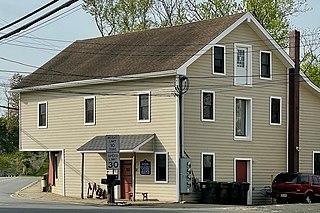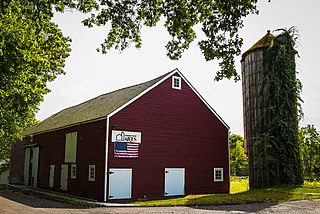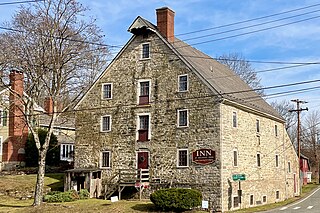
Mays Landing is an unincorporated community and census-designated place (CDP) located within Hamilton Township, Atlantic County, in the U.S. state of New Jersey. At the 2010 U.S. census, May's Landing's population was 2,135. It is the county seat of Atlantic County.

The King Store and Homestead are historic buildings located at 209 and 211 Main Street, in the Ledgewood section of Roxbury Township, in Morris County, New Jersey, United States. The Roxbury Historic Trust acts as curator for these Roxbury Township-owned buildings. They were purchased by the Township with Green Acres funding. The buildings were added to the National Register of Historic Places on April 29, 1994, for their significance in commerce from 1815 to 1928. Both were later added as contributing properties to the Ledgewood Historic District on April 18, 2013.

The Cape May Historic District is an area of 380 acres (1.5 km2) with over 600 buildings in the resort town of Cape May, Cape May County, New Jersey. The city claims to be America's first seaside resort and has numerous buildings in the Late Victorian style, including the Eclectic, Stick, and Shingle styles, as well as the later Bungalow style, many with gingerbread trim. According to National Park Service architectural historian Carolyn Pitts, "Cape May has one of the largest collections of late 19th century frame buildings left in the United States... that give it a homogeneous architectural character, a kind of textbook of vernacular American building."

Church of the Ascension was a historic church building at 1601 Pacific Avenue in Atlantic City, Atlantic County, New Jersey, United States. The church was built in 1893 and demolished in July 2017.

Mays Landing Presbyterian Church is a historic church built in 1841 and located at Main Street and Cape May Avenue in the Mays Landing section of Hamilton Township in Atlantic County, New Jersey, United States. It was documented by the Historic American Buildings Survey (HABS) in 1938 and was added to the National Register of Historic Places on April 20, 1982, for its significance in architecture and religion. The church was added as a contributing property to the Mays Landing Historic District in 1990.
Weymouth was a schooner that carried coal on the Great Egg Harbor River. She was built in 1868 as a 60-ton, two-masted schooner by carpenter Samuel Gaskill at what is now Gaskill Park, Mays Landing, New Jersey. She was used to ship charcoal and other goods produced in the Pine Barrens along the Atlantic coast until the early 1890s, when she was left tied to a dock, as was common with retired merchant ships at the time. She came loose from her dock on the Great Egg Harbor River and ran aground on tidal mud flats about a mile downstream; her owners, lacking the money to move her, abandoned her.

John and Anna Vreeland House, also known as the Hamilton House, is located at 971 Valley Road in the city of Clifton in Passaic County, New Jersey, United States. The farmhouse, built c. 1817 by Anna and John Vreeland, is one of the last symbols of Dutch settlement in the city and one of the finest examples of early 19th century stone houses in the county according to the nomination form. It was added to the National Register of Historic Places on May 13, 1982, for its significance in architecture. It is now operated by the city as a house museum, the Hamilton–Van Wagoner House Museum.

The Lambertville House is a historic building located at 32 Bridge Street in the city of Lambertville in Hunterdon County, New Jersey, United States. The stone section was built in 1812 by Captain John Lambert. It was added to the National Register of Historic Places on September 6, 1978, for its significance in architecture, commerce, and communications. It was listed as a contributing property of the Lambertville Historic District on June 30, 1983. Today, it is a hotel with restaurant and business meeting rooms.

Atsion is an unincorporated community located within Shamong Township in Burlington County, in the U.S. state of New Jersey. The community is located next to Atsion Lake.

The Amanda Blake Store is a historic building located at 104 Main Street in the city of Port Republic in Atlantic County, New Jersey. Built in 1884 as a general store, it was added to the National Register of Historic Places on January 25, 1979, for its significance in commerce and social history. It is now a privately-owned house. The building was listed as a contributing property of the Port Republic Historic District in 1991.

Walnford is an unincorporated community located along Crosswicks Creek within Upper Freehold Township in Monmouth County, in the U.S. state of New Jersey. Walnford was named for Richard Waln, the original owner of the town site.

The Mountain Avenue Historic District is a stretch of historic houses on Mountain Avenue in Princeton, New Jersey that date to the 19th and early 20th centuries. The 9-acre (3.6 ha) historic district was added to the National Register of Historic Places on February 2, 1995, for its significance in architecture and community planning. It includes 14 contributing buildings, and encompasses the north side of the road between the west side of the Mountain Lakes Preserve and Quarry Lane.

The historic 1838 Atlantic County Courthouse is located at 5901 Main Street in Mays Landing, the county seat of Atlantic County, in Hamilton Township, New Jersey, United States.

Dunham's Mill, also known as Parry's Mill, is a historic building located at 7 Lower Center Street in Clinton, New Jersey, United States. The gristmill was in operation from 1837 to 1952. It was added to the National Register of Historic Places on April 15, 1982, for its significance in commerce and industry. In 1995, it was also listed as a contributing property of the Clinton Historic District. It shares the Clinton Dam across the South Branch Raritan River with the David McKinney Mill on the other side of the river. Since 1952, it has been home to the Hunterdon Art Museum, described by an art critic as the "most charming and picturesque" museum in the state.

The James Townley House is a historic farmhouse on the campus of Kean University located at the intersection of Morris Avenue and Green Lane in Union Township, Union County, New Jersey. It was documented by the Historic American Buildings Survey (HABS) in 1939. The house was added to the National Register of Historic Places on May 14, 1979, for its significance in architecture.

Salter's Mill is a historic gristmill built c. 1897 and located at 33 Imlaystown Road in the Imlaystown section of Upper Freehold Township in Monmouth County, New Jersey. It was added to the National Register of Historic Places on September 29, 1980, for its significance in agriculture, architecture, and exploration/settlement. The mill is next to a 28-acre (11 ha) mill pond, which was also used in the ice business. In 1985, it was also listed as a contributing property of the Imlaystown Historic District.

Franklin Corners is an unincorporated community located along the Passaic River at the intersection of County Route 613 and U.S. Route 202 in Bernards Township of Somerset County, New Jersey. In the 19th century, it had a grist mill, saw mill, general store, school, and several houses. The Franklin Corners Historic District, featuring Van Dorn's Mill, was listed on the National Register of Historic Places in 1975.

The Kennedy–Martin–Stelle Farmstead is located at 450 King George Road in Bernards Township of Somerset County, New Jersey. The 4.4-acre (1.8 ha) farmstead was added to the National Register of Historic Places on May 5, 2004 for its significance in architecture, education and politics/government from 1762 to 1852. The farmstead includes four contributing buildings and two contributing structures. It is now the home of the Farmstead Arts Center.

The Reynolds–Scherman House is a historic house located at 71 Hardscrable Road in the borough of Bernardsville in Somerset County, New Jersey. It was added to the National Register of Historic Places on April 29, 1989, for its significance in architecture, industry, and literature.

The Hope Historic District is a 40-acre (16 ha) historic district encompassing the Hope section of Hope Township in Warren County, New Jersey, United States. It was added to the National Register of Historic Places on July 20, 1973, for its significance in architecture, community development, commerce, engineering, exploration/settlement, industry, and religion. The district includes 17 contributing buildings, 1 contributing site, and 1 contributing structure. St. Luke's Episcopal Church was later listed individually on the NRHP.























